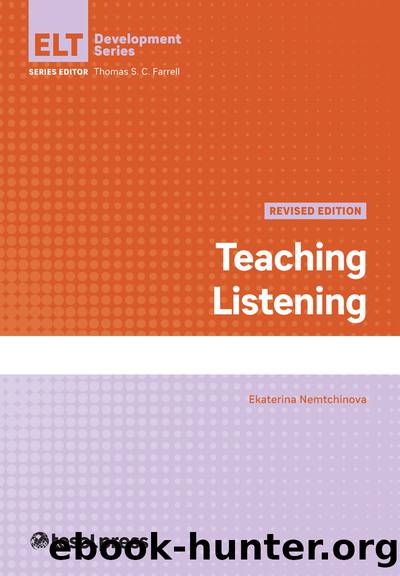Teaching Listening, Revised Edition by Nemtchinova Ekaterina;

Author:Nemtchinova, Ekaterina;
Language: eng
Format: epub
Publisher: TESOL Press
Published: 2020-08-15T00:00:00+00:00
The Role of Teacher
REFLECTIVE QUESTION
What characteristics make a good teacher of second language listening skills?
When teachers teach, they seem to take charge of everything. They select input, design and sequence activities, determine tasks, and decide what constitutes a correct response. When several students give the desired answer, the teacher acknowledges their effort and moves on, never pausing to think if everyone in the class understood the text, and if not, what caused their confusion. When students make a mistake, teachers deem it their professional duty to immediately correct it. By doing that, teachers hope they are keeping the lesson going and also helping learners avoid the same mistake in the future. This approach puts the teacher in control of classroom activity and allows students to check the accuracy of their responses, but does it change studentsâ listening behavior?
In a process-oriented classroom, the teacher assumes a more supportive role, facilitating rather than controlling and testing listening. He or she continues to manage the classroom business of planning, implementing, and assessing listening while taking a noninterventional stance in listening instruction (Field, 2008). Instead of presenting students with the correct answer, the teacher guides them in comparing responses and reflecting on different steps they took to achieve comprehension. He or she encourages students to become aware of their listening, monitors their efforts, and provides feedback on their performance.
It is essential that students receive feedback immediately after the task, while they still remember the activity. At the same time, teachers do not want to embarrass weaker listeners in front of their classmates, so the discussion of common errors and ways to avoid them should be impersonal and nonjudgmental (There were some problems with ⦠instead of You made a mistake in ⦠). Personal feedback can be spoken or written; a quick in-class conference right after the activity may be followed by an email message with observations and suggestions after class. Individual comments should be transparent, targeting specific strengths and weaknesses and providing tips for improvement. A good strategy is to start with a general positive statement (You did a great job understanding all the reasons the speaker stated), mention areas for improvement (I didnât see you taking notes while listening. Did you pay attention?), and finish with encouragement (You managed to understand a lot from the text) to sustain confidence and create a positive listening environment where students are not afraid to try new strategies, make guesses, and discuss. To relieve anxiety associated with listening in a foreign language, I also tell my students about my own auditory problems (such as replaying phone messages eight times to get the phone number) and find ways to praise even their smallest successes to give them a sense of accomplishment.
Download
This site does not store any files on its server. We only index and link to content provided by other sites. Please contact the content providers to delete copyright contents if any and email us, we'll remove relevant links or contents immediately.
Housekeeping by Marilynne Robinson(4347)
Papillon (English) by Henri Charrière(4195)
The Poetry of Pablo Neruda by Pablo Neruda(4039)
World without end by Ken Follett(3428)
TCP IP by Todd Lammle(3134)
Fluent Forever: How to Learn Any Language Fast and Never Forget It by Gabriel Wyner(3028)
The Rape Of Nanking by Iris Chang(2774)
How Proust Can Change Your Life by Alain De Botton(2742)
The Alchemist by Paulo Coelho(2644)
The Partner by John Grisham(2346)
Two lives by Helen Naylor(2270)
Hitler by Ian Kershaw(2152)
Yerma by Federico García Lorca(2016)
Sophie's World by Jostein Gaarder(1968)
Smilla's Sense of Snow by Peter Hoeg(1905)
Merriam-Webster's Pocket Dictionary by Merriam-Webster(1882)
Twilight of Idols and Anti-Christ by Friedrich Nietzsche(1850)
Il cavaliere inesistente by Italo Calvino(1825)
Deep Writing by Eric Maisel(1784)
